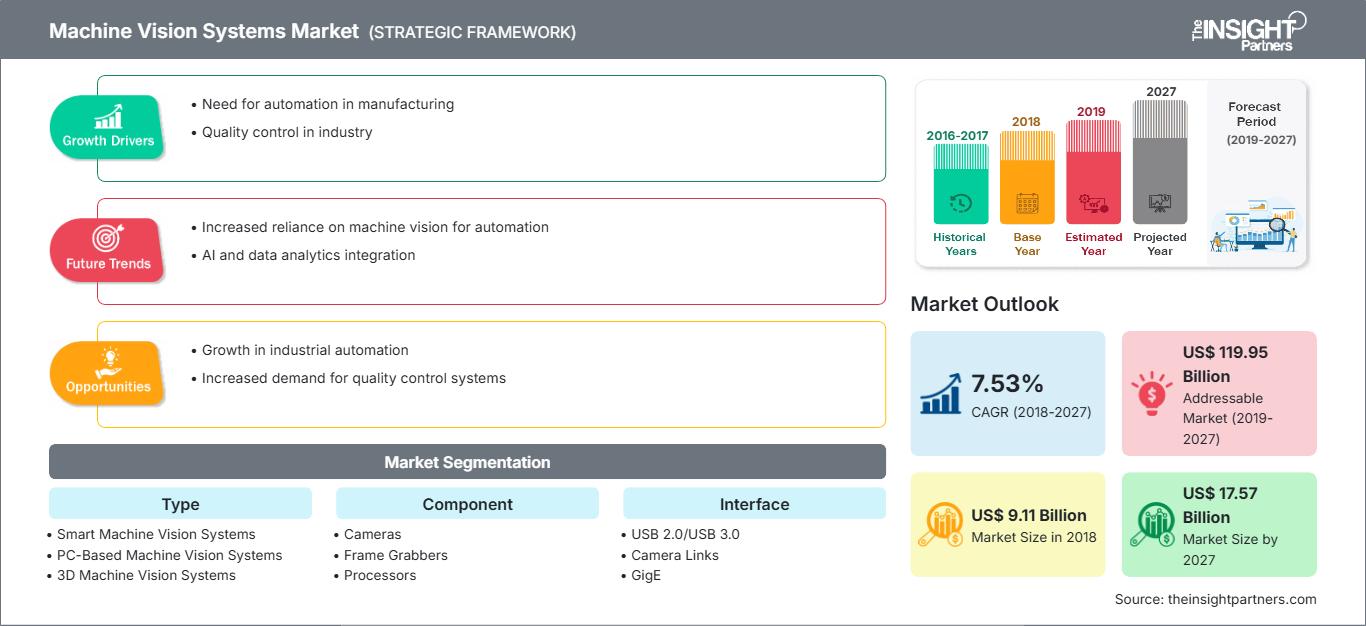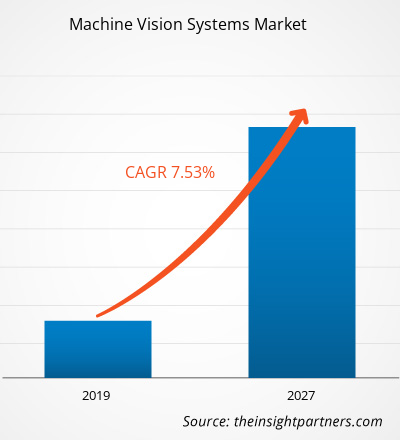2025 年机器视觉系统市场价值为 203.7 亿美元,预计到 2034 年将达到 534 亿美元,在 2026 年至 2034 年期间的复合年增长率为 12.80%。
机器视觉系统市场分析
受工业领域自动化程度不断提高、视觉检测和测量需求日益增长以及对提升运营效率的需求等因素的推动,机器视觉系统市场蓄势待发,即将迎来增长。这些系统由摄像头、软件、光学元件和传感器组成,能够为制造业及相关行业提供检测、识别、测量和检验等服务。此外,对机器人技术、工业4.0集成以及视觉引导系统的日益重视,也进一步推动了市场扩张。
机器视觉系统市场概览
机器视觉系统 (MVS) 是一种智能自动化解决方案,它利用摄像头、照明、光学元件和处理算法来模拟人类视觉在工业操作中的应用。这些系统通过自动化检测、引导机器人、实现测量和验证任务以及减少对人工的依赖,从而简化操作流程。MVS 解决方案在制造业、汽车业、电子业和其他行业中正变得日益重要,能够提高生产效率、精度和质量标准合规性。
根据您的需求定制此报告
您可以免费获得任何报告的定制服务,包括本报告的部分内容、国家/地区层面的分析、Excel 数据包,以及面向初创企业和高校的优惠折扣。
机器视觉系统市场:战略洞察

-
获取本报告的主要市场趋势。这份免费样品将包含数据分析,内容涵盖市场趋势、估算和预测等。
机器视觉系统市场驱动因素和机遇
市场驱动因素:
- 制造业对高质量产品检验和更快生产周期的需求日益增长。
- 汽车、电子等行业对机器人和视觉引导自动化技术的应用日益广泛。
- 政府举措和投资支持智能工厂、自动化和工业数字化。
市场机遇:
- 向工业自动化发展势头强劲的新兴市场扩张,例如亚太地区。
- 集成实时分析、机器学习和 3D 视觉系统,以实现更复杂的检测和机器人应用。
机器视觉系统市场细分分析
按类型:
- 智能机器视觉系统
- 基于PC的机器视觉系统
- 3D机器视觉系统
按组件:
- 相机
- 帧捕获器
- 处理器
- 照明与光学
- 视觉软件
- 视觉传感器及其他
按接口:
- USB 2.0 / USB 3.0
- Camera Link
- 千兆以太网
- CoaXPress
按最终用途行业划分:
- 汽车
- 电子与半导体
- 食品和饮料
- 制药
- 后勤
按地理位置:
- 北美
- 欧洲
- 亚太地区
- 南美洲和中美洲
- 中东和非洲
机器视觉系统市场区域洞察
The Insight Partners 的分析师对预测期内影响机器视觉系统市场的区域趋势和因素进行了详尽的阐述。本节还探讨了北美、欧洲、亚太、中东和非洲以及南美和中美洲等地区的机器视觉系统市场细分和地域分布。
机器视觉系统市场报告范围
| 报告属性 | 细节 |
|---|---|
| 2025年市场规模 | 203.7亿美元 |
| 到2034年市场规模 | 534亿美元 |
| 全球复合年增长率(2026-2034 年) | 12.80% |
| 史料 | 2021-2024 |
| 预测期 | 2026-2034 |
| 涵盖部分 |
按类型
|
| 覆盖地区和国家 |
北美
|
| 市场领导者和主要公司简介 |
|
机器视觉系统市场参与者密度:了解其对业务动态的影响
受终端用户需求不断增长的推动,机器视觉系统市场正快速发展。终端用户需求增长的驱动因素包括消费者偏好的转变、技术的进步以及消费者对产品优势的认知度提高。随着需求的增长,企业不断拓展产品和服务,创新以满足消费者需求,并把握新兴趋势,这些都进一步推动了市场增长。

- 获取机器视觉系统市场主要参与者概览
机器视觉系统市场份额地域分析
北美
- 凭借先进的制造基础设施、自动化和视觉系统的早期应用,占据了相当大的市场份额。
- 趋势:汽车和电子行业越来越多地使用视觉引导机器人和智能摄像头。
欧洲
- 汽车和电子行业大力推动工厂自动化和标准遵守,公共和私营部门均积极响应。
- 趋势:采用可互操作的视觉系统和跨境制造优化。
亚太地区
- 增长最快的地区归功于制造业基地的扩张、工业自动化程度的提高以及对视觉系统投资的增加。
- 趋势:在中国、印度和东南亚,检测、电子制造、包装和汽车行业正在迅速采用。
南美洲和中美洲
- 新兴市场对经济高效的视觉检测系统和工厂自动化需求不断增长。
- 趋势:中小制造商采用模块化视觉系统进行质量控制。
中东和非洲
- 该地区正在发展中,基础设施投资不断增加,制造业、石油天然气和物流业的自动化程度也在不断提高。
- 趋势:视觉检测和机器人技术在新兴制造中心的应用。
机器视觉系统市场参与者密度:了解其对业务动态的影响
机器视觉系统市场既有全球巨头,也有众多区域性专业厂商,因此竞争程度适中,且技术密集度较高。领先供应商通过以下方式实现差异化:
- 先进集成了3D视觉、人工智能和智能摄像头模块。
- 可扩展的解决方案,满足小型和大型制造商的需求。
- 与机器人、自动化和软件供应商建立合作关系,提供端到端的视觉驱动解决方案。
机器视觉系统市场的主要运营公司包括:
- 巴斯勒股份公司
- 康耐视公司
- 数据逻辑公司
- FLIR Systems, Inc.
- IDS 成像开发系统有限公司
- ISRA VISION AG
- 基恩士公司
- OmniVision Technologies, Inc.
- 欧姆龙微扫描系统公司
- 东芝泰力株式会社
研究过程中分析的其他公司:
- Microscan Systems, Inc.
- 美国国家仪器公司
- 索尼公司
- 泰莱科技公司
- 联合视觉技术有限公司
- JAI A/S
- 生病的AG
- 鲍默控股股份公司
- Vision Components GmbH
- Tordivel AS
机器视觉系统市场新闻及最新发展
- 新闻稿证实,机器视觉系统市场预计到 2027 年将达到 175.7 亿美元(以 2018 年为基准年)。
- 智能机器视觉系统和 3D 机器视觉系统市场前景强劲,正被汽车、电子半导体和物流等行业广泛采用。
- 主要参与者正通过人工智能、3D成像以及与机器人制造商的合作来扩展能力,以增强检测和自动化任务。
机器视觉系统市场报告涵盖范围及成果
The Insight Partners发布的《机器视觉系统市场——全球分析与预测(2021-2034)》报告提供了以下信息:
- 涵盖范围内所有关键细分市场的全球、区域和国家层面的市场规模和预测。
- 市场趋势和动态,例如驱动因素、制约因素和机遇。
- 详细的PEST和SWOT分析。
- 分析内容涵盖关键市场趋势、监管框架、主要参与者和最新发展。
- 行业格局和竞争分析,包括市场集中度、热力图分析、主要参与者和最新发展。
- 主要参与者的详细公司简介。
- 历史分析(2 年)、基准年、预测(7 年)及复合年增长率
- PEST和SWOT分析
- 市场规模、价值/数量 - 全球、区域、国家
- 行业和竞争格局
- Excel 数据集
近期报告
客户评价
购买理由
- 明智的决策
- 了解市场动态
- 竞争分析
- 客户洞察
- 市场预测
- 风险规避
- 战略规划
- 投资论证
- 识别新兴市场
- 优化营销策略
- 提升运营效率
- 顺应监管趋势






















 获取免费样品 - 机器视觉系统市场
获取免费样品 - 机器视觉系统市场